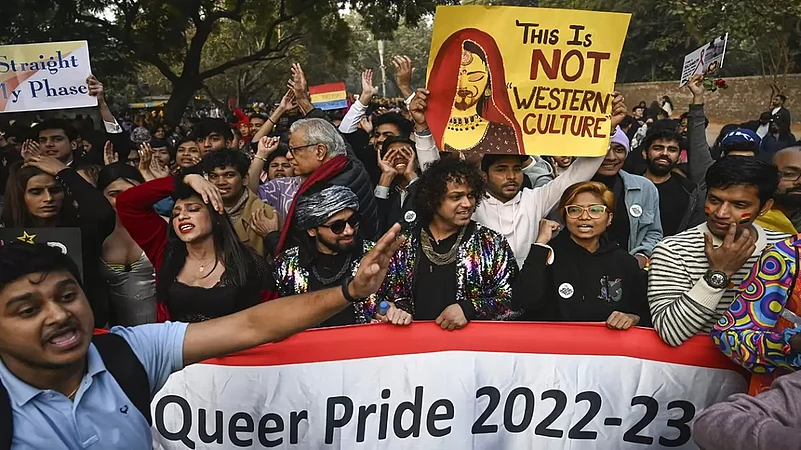Today,?the month of Pride begins. Cities across the world will see colourful parades, rainbow-coloured flags flying high in the sky and?people decked up in bright clothing with flags painted on their cheeks?to show solidarity with the LGBTQIA+ community. The march has grown since its inception in the 1960s and become a global symbol of celebrating and accepting identities.?
Tracing The History Of Pride Month
The history of the Pride movement in India intertwines profoundly with the narrative surrounding Section 377 of the Indian Penal Code (IPC), an outdated provision?of the British colonial era that deemed homosexuality illegal

India has made significant strides in?recognising LGBTQIA+?rights in recent years.?In a landmark verdict, the Supreme Court decriminalized?homosexuality in 2018, paving way for further advancement of?the community's rights.?But homosexuality and same-sex marriage still remain taboo topics in the country, with the government too?largely opposing?the issue—arguing that the matter should be decided in parliament.
In April, the Indian Supreme Court began hearing a series of petitions from 18 LGBTQIA+ couples, including three who are raising children together, seeking?legal recognition of same-sex marriage. A verdict is expected in the coming months.?If the court rules in favor of the petitioners, India will become the first country in South Asia, and the second country in Asia?after Taiwan, to legalize same-sex marriage.
History of Pride
The Stonewall Riots on the night of June 28, 1969, are often thought to be the starting point of the gay rights movement in the US. The police raided the Stonewall Inn in New York City,?reportedly running without a liquor licence.?
It was a time when homosexuality was a criminal offence. Gay bars were places where gay, lesbians, and others in the queer community socialised away from public harassment. The Stonewall Inn was one such place.?It was the third such raid on the bars in the area, according to the?Britannica Encyclopaedia.
However, the Stonewall Inn raid was different. People did not retreat or scatter as in the past. Rather, they began to jeer and jostle with the police as they put bar patrons in vans, as per?Britannica. It adds that people threw beer bottles and debris at the police, forcing police personnel to barricade themselves behind the bar and call for reinforcements. As the police barricaded inside, around 400 people rioted outside and set the bar on fire.?
It was the first of the confrontation with the police, which continued till July 3, 1969.?There are multiple versions of the events at the Stonewall Inn, but all versions agree that the incident led to the larger the LGBTQ rights movement.
Experts and scholars also refer?to some other similar but equally significant incidents and uprisings that happened in the years prior to Stonewall—for instance, the one at?Cooper Donuts in Los Angeles (1959), the protests at?Compton Cafeteria in San Francisco (1966)?and the LGBT demonstration at?Black Cat Tavern also in Los Angeles (1967).
Many of these protests were in response to the increasing police brutality against members of the drag/transgender community all across the US.
Pride In India?
The history of the Pride movement in India intertwines profoundly with the narrative surrounding Section 377 of the Indian Penal Code (IPC), an outdated provision?of the British colonial era that deemed homosexuality illegal. The narrative persisted beyond the nation's independence,?despite the existence of Article 14 in the Indian Constitution, which?pledged equality for all.
It was on August 11, 1992. The first known?protest for gay rights in India?happened right?outside the police headquarters in Delhi’s ITO area, in response to police action against few men from Central Park in Connaught Place on the suspicion of homosexuality.?The protests were?spearheaded by the AIDS Bhedbhav Virodhi Andolan (ABVA).
In 1994, ABVA also filed a public interest litigation (PIL) challenging the constitutional validity of Section 377 of IPC in the Delhi High Court. It is considered to be one of the first legal protests against the government repression of the LGBTQIA+ community in India.
On July 2, 1999, India held its?first Pride Parade?in Kolkata. Called the Kolkata Rainbow Pride Walk, the march was the first-ever Pride march in South Asia.?Since this momentous event, Pride marches have been held in over 21 Indian cities.
LGBTQIA+ Rights In India
But the Indian government, led by Prime Minister Narendra Modi’s Bharatiya Janata Party, has formally opposed the issue of same-sex marriage.?According to?Pink List India, the country’s first archive of politicians supporting LGBTQ+ rights, 115 of 161 Members of Parliament who have publicly weighed in on the same-sex marriage debate have expressed support, with most of them belonging to the ruling BJP.
The Union government has consistently rejected the idea of same-sex marriages even before the court hearings commenced.?The Centre had said such recognition would create "havoc" in society and had called it an "urban elite" issue, which was rebutted to by advocates representing the LGBTQIA+ couples.?Union ministers have also stated that the government does not accept same-sex marriages and have said that the Parliament should take the call on the issue, not the Supreme Court.
- Previous Story
 Elections 2024: Ashok Tanwar Joins Congress Again; Sehwag Endorses Congress Candidate In Haryana
Elections 2024: Ashok Tanwar Joins Congress Again; Sehwag Endorses Congress Candidate In Haryana - Next Story
























